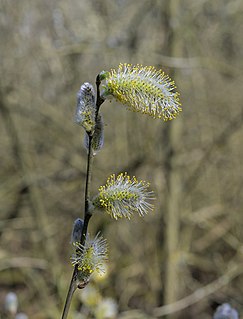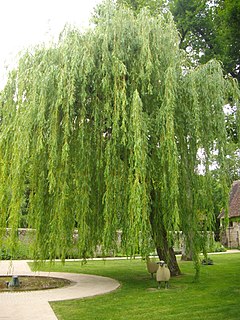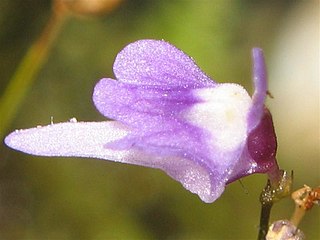
Salix alba, the white willow, is a species of willow native to Europe and western and central Asia. The name derives from the white tone to the undersides of the leaves.

Salix caprea, known as goat willow, pussy willow or great sallow, is a common species of willow native to Europe and western and central Asia.

Salix purpurea, the purple willowpurpleosier willow or purple osier, is a species of willow native to most of Europe and western Asia north to the British Isles, Poland, and the Baltic States.

Salix × fragilis, with the common names crack willow and brittle willow, is a hybrid species of willow native to Europe and Western Asia. It is native to riparian habitats, usually found growing beside rivers and streams, and in marshes and water meadow channels. It is a hybrid between Salix euxina and Salix alba, and is very variable, with forms linking both parents.

Salix babylonica is a species of willow native to dry areas of northern China, but cultivated for millennia elsewhere in Asia, being traded along the Silk Road to southwest Asia and Europe.

Fragaria nipponica is a species of wild strawberry native to the western side of the Japanese island of Honshū, with a variety Fragaria nipponica var. yakusimensis on Yakushima. Some botanists treat it as a synonym of Fragaria yezoensis.

Salix nigra, the black willow, is a species of willow native to eastern North America, from New Brunswick and southern Ontario west to Minnesota, and south to northern Florida and Texas.

Salix lasiolepis is a species of willow native to western North America.

Salix magnifica is a species of willow in the family Salicaceae. It is endemic to Sichuan in southwestern China, where it grows at high altitudes of 2,100–3,000 m above sea level. It is threatened by habitat loss.

Salix triandra, with the common names almond willow, almond-leaved willow or black maul willow, is a species of willow native to Europe and Western and Central Asia. It is found from south-eastern England east to Lake Baikal, and south to Spain and the Mediterranean east to the Caucasus, and the Alborz Mountains. It usually grows in riparian habitats, on river and stream banks, and in wetlands.

Utricularia minutissima is a small or very small terrestrial carnivorous plant that belongs to the genus Utricularia. U. minutissima is native to Asia and Australia. Among the islands of Southeast Asia, it is found on Borneo, New Guinea, and Sumatra.

Salix geyeriana is a species of willow known by the common names Geyer's willow, Geyer willow and silver willow. The type specimen was collected by the botanist Karl Andreas Geyer, for whom it was named. Its conspicuous, yellow flowers begin to bloom as early as March, to as late as the end of June.

Prunus nipponica, also called Japanese alpine cherry, is a shrub which originates from the islands of Hokkaido and Honshu, Japan. It grows to a height of about 5 meters (16 ft) and can grow in sandy, loamy, and clay soils.

Salix repens, the creeping willow, is a small, shrubby species of willow in the family Salicaceae, growing up to 1.5 metres in height. Found amongst sand dunes and heathlands, it is a polymorphic species, with a wide range of variants. In the UK, at least, these range from small, prostrate, hairless plants at one end of the spectrum to taller, erect or ascending silky-leaved shrubs at the other. This wide variation in form has resulted in numerous synonyms.
Salix annulifera is a small shrub from the genus of the willow (Salix) with up to 8 centimeter long leaf blades. The natural range of the species is in China.
Salix calyculata is a low shrub in the willow genus Salix with mostly 8 to 15 millimeter long leaf blades. The natural range of the species is in China, Sikkim, and Bhutan. A distinction is made between two varieties.
Salix cheilophila is a shrub or small tree from the genus of willow (Salix) with initially tomentose hairy and later balding branches. The leaf blades have lengths of 2.5 to sometimes 6 centimeters. The natural range of the species is in China.
Salix eriostachya is a species from the genus of willows (Salix) and grows as a shrub. The leaf blades are 4 to 11 centimeters long. The natural range of the species is in India, Nepal, and China.













